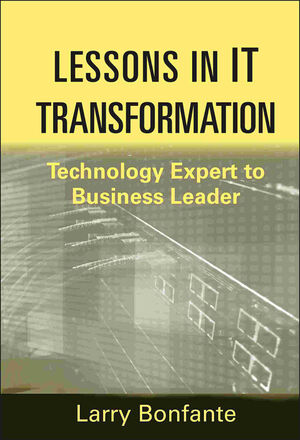Lessons in IT Transformation: Technology Expert to Business LeaderISBN: 978-1-118-00447-0
Hardcover
224 pages
May 2011
 |
||||||
Introduction.
Chapter 1 First Things First: What Is Leadership?
Defining Leadership.
Leadership versus Management.
Misconceptions About Leadership.
Leadership Roles.
Chapter 2 That Vision Thing.
Importance of Vision.
Deciding Whose Vision It Is.
Helping Employees Feel Ownership.
Creation the Vision.
Aligning Your Vision with the Vision of Your People.
Inspiring Others to Share the Vision.
Making the Vision Real for People.
Chapter 3 It's the Business, Stupid!
The Purpose of IT.
The Foolishness of Alignment.
Three Questions About IT's Role in the Organization's Mission.
Fiscal Management – IT Is an Investment Not a Cost.
IT as a Tool to Drive Revenue.
Ways to Engage the Board.
The CIO as Business Leader, Not Technologist.
Meaningful Metrics.
Focus on What Matters.
Managing Perception versus Reality.
Chapter 4 Communication.
The Importance of Communication.
The Importance of Listening.
Who Do I Need to Communicate With?
How Should I Communicate with Them?
The Need for Marketing.
What is Your Brand?
Leading a Volunteer Army.
Communicating Tough Messages.
Focusing on the Issue, Not the Person.
Honesty and Transparency.
Chapter 5 Relationship Management.
No Man (or Woman) Is an Island.
Helping Other People Succeed.
Being a Team Builder.
Building Credibility.
The Law of WIFM – What's in it for Me?
Leading by Serving.
What People Feel About You Is More Important than Reality.
Chapter 6 Developing Human Capital.
Leading “Persons”.
Leveraging People's Unique Talents.
Engaging the Whole Person.
Focusing on Strengths.
Recruitment/Retention/Development.
Making Sure a Person Is Better Off for Having Had the Experience.
Recognizing and Rewarding Your People's Efforts and Successes.
Chapter 7 Leading the Process of Change.
Change Is Uncomfortable.
Selling the Need for Change.
Personalizing the Need for Change.
Making Change a Part of Your Culture.
Building Community.
Ensuring Buy-in.
Breaking Change into Bite-sized Chunks.
Supporting Progress along the Way.
Celebrating and Communicating Progress/Success.
Comparing Position versus Influence.
Balancing Change with Discipline Project Management.
Developing a Culture of Innovation.
Developing a Culture of Accountability.
Chapter 8 Partnering for Success.
Some Words Are Used Too Loosely.
Creating an Empowered, Team-oriented Environment.
Adjusting to the Twenty-first-century Workforce.
Partnering with Your Team.
Partnering with Your Clients.
Partnering with Your Executive Management and Board of Directors.
Sourcing – Expanding Your Team to Include Outside Partners.
Networking in the Industry.
Chapter 9 Developing the Qualities of Great Leader.
Being Authentic.
Inspiring Others.
Building Trust.
Showing Humility.
Having a Bias Toward Action.
Leveraging Collective Wisdom.
Building Personal Relationship.
Influencing Others.
Showing Your Humanity.
Empowering the People Around You.
Being Receptive to Feedback.
Being Likable.
Being Accountable.
The Most Important Characteristic of a Leader – Having Integrity.
Chapter 10 Sustainability.
Accomplishing Short-term Success Is Only the First Step.
Individual Leaders Can Drive Short-term Success.
You Need a Culture of Leadership to Ensure Long-term Viability.
A Leader's Job Is Not Only Creating Success – It is Creating Other Leaders.
Chapter 11 Homework and Parting Thoughts.
Leadership Begins with Me!
I am IT!
Be Wary of Linda Ronstadt Disease.
Seek Alignment versus Consensus
God Gave You Two Ears and One Mouth.
How Do You Feel When You Are the Customer?
Leadership Is a Responsibility, Not a Privilege.
You are Either Part of the Solution or Part of the Problem – the Choice Is Yours.
There Are Three Kinds of People in the World.
When You Change, Your World Changes.
About the Author.
Index.



